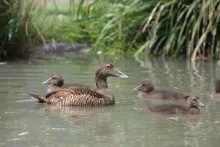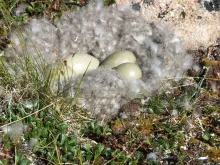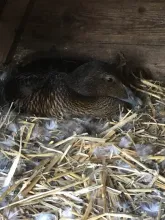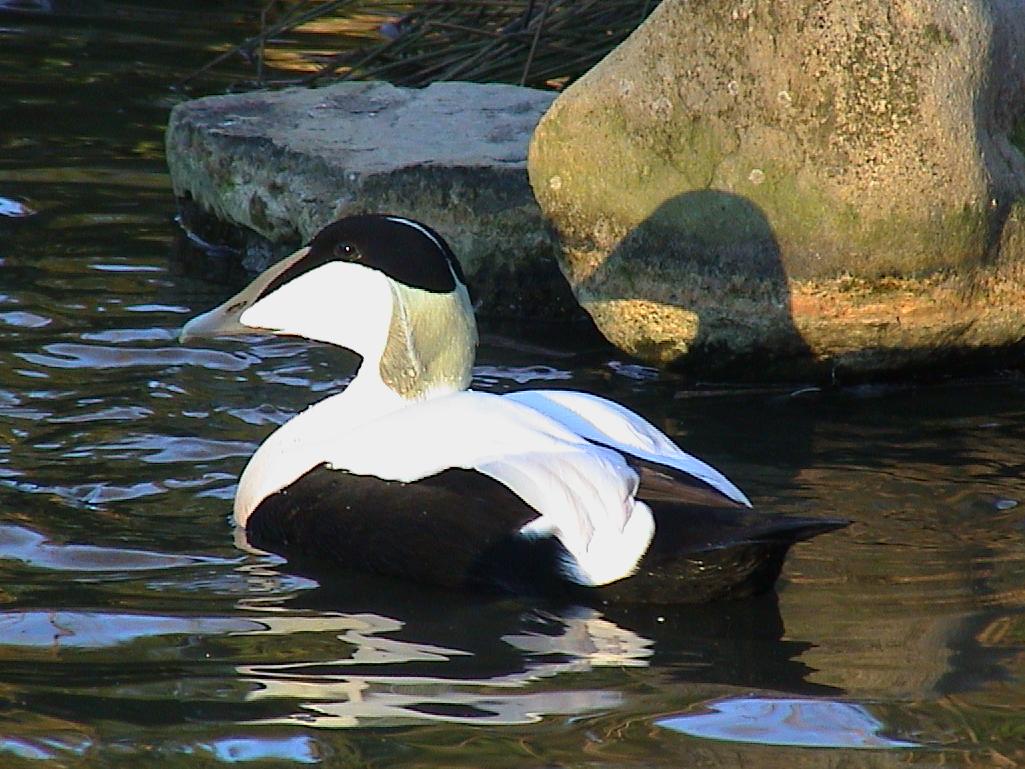
Eider, Common (Somateria mollissima)
Species name
- Dutch name:
- Eidereend
- English name:
- Common Eider
- German name:
- Eiderente
- French name:
- Eider à duvet
- Scientific name:
- Somateria mollissima
Scientific classification
- Order:
- Anseriformes
- Family:
- Anatidae
- Onderfamilie:
- Merginae
- Genus:
- Somateria
Description
- Description:
The common eider is both the largest of the four eider species. It is characterized by its bulky shape and large, wedge-shaped bill.
Male:
Is unmistakable, with its black and white plumage and green nape. Bill being olive green, yellowish green to bright orange amongst the sup species.Female:
Is a brown bird, but can still be readily distinguished from all ducks, except other eider species, on the basis of size and head shape. The drake's display call is a strange almost human-like "ah-ooo," while the hen utters hoarse quacks.
- Behaviour:
The species is often readily approachable.
Standard Measurements
- Body Length (cm):
- The male (drake) of the Eider, Common measures approximately 50-71 centimeters. The female measures approximately 50-71 centimeters.
- Body Weight (grams):
- The male will weight about 1980-2460 gram. The female will weight about 1800-2240 gram.
The weight is notoriously variable and can only be used as indication!
- Subspecies:
Drakes of the European, eastern North American and Asia/western North American races can be distinguished by minor differences in plumage and bill colour. Faeroes Eider (faeroeensis), Northern Eider (borealis), Hudson Bay Eider (sedentaria), Dresser's Eider, Atlantic Eider (dresseri). Some authorities place the subspecies v-nigra as a separate species.
- Somateria mollissima mollissima – Common Eider – breeds from NW Europe E to Novaya Zemlya; winters S to Atlantic coast of France and N Mediterranean Basin.
- Somateria mollissima faeroeensis – Faeroe Is, Shetland Is and Orkney Is, and Outer Hebrides (W Scotland).
- Somateria mollissima borealis – breeds in Arctic Atlantic from Groswater Bay (Labrador) N to Southampton I and Baffin I, E through Greenland and Iceland to Franz Josef Land; in winter, around coasts of N Atlantic, reaching Gulf of St Lawrence.
- Somateria mollissima sedentary – Hudson Bay and James Bay region.
- Somateria mollissima dresseri – breeds in NE North America from Groswater Bay (Labrador) S to Massachusetts; in winter from Gulf of St Lawrence S to Long I, New York.
- Somateria mollissima v-nigrum – Pacific Eider – New Siberian Is (NE Siberia) E to NW North America; winters Bering Sea and Aleutian Is.
- Note:
Common eiders are winter-hardy, easy to maintain and not quarrelsome.but may suffer in summer from heat. Clear, cold running water is ideal, and some shade should be available on shores. High-protein feed is important.
Some subspecies are fairly easy to breed. They prefer to lay in close or open ground cover: in grass or other vegetation on islands, or in bankside vegetation, and they also use ground level nest boxes or baskets. Usually lay in May to June. These ducks are reliable incubators, but hand-rearing is recommended, being easier for controlling feeding, on clear water and with plentiful food.
Hybrids have been mentioned with King eider (Somateria spectabilis), Northern pintail (Anas acuta), Mallard (Anas platyrhynchos).
- Breeding:
- The female Eider, Common usually lays from 4-6 gray-green eggs and incubates them for 28 days.
- Artificial incubating:
The ideal relative humidity for incubating most waterfowl eggs is 55% (ground nesters) and 40% (cavity nesters). The temperature is usually 37.4°C. Set ventilation as recommended by the incubator manufacturer. Eggs must be turned, either automatically or by hand, a minimum of 4 times a day. As the duckling develops there is a loss of water from the egg and the air sac gets bigger. In normal development of an egg with a 28 days incubation, the air sac occupies about a third of it three days earlier. Cleanliness is vital and ideally eggs should be moved to a separate hatcher at this point, where the humidity should be increased to 65% and even higher once they have pipped internally.
- Bird banding:
- Recommended closed leg band ring size for the Eider, Common is 13 mm.The leg band ring can only be applied on a young sea duck at around 14 days old.
- It doesn't matter what leg that you band, but it's good to have a consistent system. Suggested: Left leg = Female, Right leg = Male
- Rearingfeed:
-

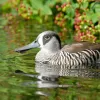

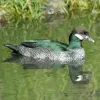
The best floatable special rearing feed from Lundi. This ideally balanced complete feed with 42% protein forms the perfect basis for the successful rearing of your ducks. The ducks grow well and have their perfect juvenile plumage after a short time.
Made exclusively from wholesome and selected raw materials, Lundi Micro 45 is also ideally suited for year-round feeding of waterfowl.
- Maintenance food:
-


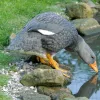
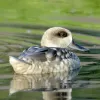
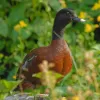


Floatable special complete food for sea birds with the highest nutritional requirements. Each chunk contains the complete nutrient spectrum. The high protein content of 35% ensures a healthy and species-appropriate diet. Spiral algae give a more magnificent coloration of plumage and sea salt promotes the salt gland.




Floating special complete food for sea birds with the highest nutritional requirements thanks to a particularly high protein content of 45%.
Ideal for daily feeding in animals that eat a lot of protein in their natural habitat. A must for "fish eaters".
- Regulation:
- Europese soort
- Regulation:
The common eider is one of the species to which the Agreement on the Conservation of African-Eurasian Migratory Waterbirds (AEWA) applies.

